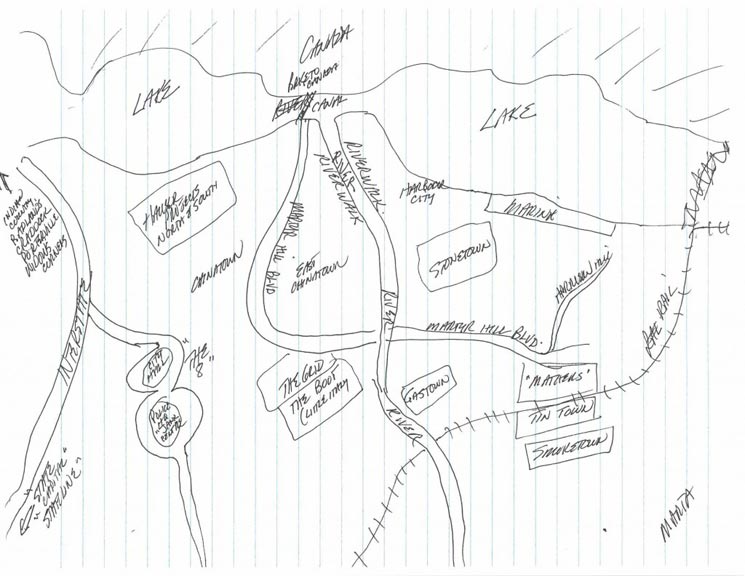
Lee Lamothe on writing: The Building of Murder City, Part 2
My requirements were simple, at first. The town, nameless, but subsequently dubbed, in later novels, Murder City because it would a violent place not unlike Toronto during periods in the 1980s and 1990s when the murder rates spiked, particularly in the ethnic communities. Where rapists were serial and bank robbers prolific.
It had to be corrupted, either by money or by ideology. Both are circumstances Toronto has undergone in the past twenty years. It had to be run by over-educated fools and lying stooges who allowed themselves to become corrupted by the greed and egomania. There had to be crooked developers who bought politicians for pennies and sold them for millions. It had to have a periodic racial disharmony, it had to be a magnet for immigration and it had to always be in change, for better or worse.
Geographically, it had to be near Canada; it had to be separated by a body of water – two, in fact, a lake with an international bridge spanning it, and a river. Several stories underway required the presence of the U.S.-Canadian border. Criminals like borders. I like bridges. Everybody likes lakes or rivers. Murder City needed hills and heavily travelled boulevards. It needed a museum and an art gallery. It needed housing for the mentally ill and the confused. It needed a skid row and a newspaper and a radio station. Not all would be used in the first novel, Free Form Jazz, but as I worked on subsequent books, not part of the series, I found new neighbourhoods were required, new ethnic restaurants. The influx into the U.S. of Mexican migrants changed Murder City a little, and would cause in a future book some inter-ethnic struggle. A SARs-like disease would change it even more.
Murder City had to be of a comparable size to Toronto where not everyone knew each other, where people still made delightful discoveries of each other and of neighbourhoods, where the underworld had similar pockets to Toronto: Asian gangs, Italian mafiosi, bikers. The city had to be populated with an array of regular citizens who could be victimized by their own government and the business community as well as by the criminal class. It had to have a police force in change, a police force where the chief was a political puppet for a loony mayor with more ideas than brains; it had to have a police force where the experience of middle managers had been retired out for political expediency, causing cynicism and frustration among real working cops. It had to have a struggling lower class and a preyed-upon underclass. It had to have, in addition to the ethnic neighbourhoods, affluent ones. It had to have an upscale neighbourhood, not unlike Yorkville, where realtors bought politicians for a free lunch. It had to have a university, various cemeteries, a marina, police sectors, high unemployment, and changing weather.
The surrounding of the city was important. It had to be near other states and cities that I could refer to. “Over in Chicago …” “Down in the capital …” For comparison, for example, in a just finished tale, reference is made to the state in which Murder City is located having a death penalty. And, because I’d spent more than a year poking around on Native reserves, the geography needed to have “Indian Country” within driving distance where, it turned out, Djuna Brown worked in a state police barracks. A friend told me a story about drug agents following a camper van; ahead of the police car the camper van simply exploded in front of them, the methamphetamine lab set up in the back igniting. So I had to have bikers who prowled their own criminal turf, “The Badlands”, where they could run riot.
The Murder City in Free Form Jazz was thin and not fully characterized. It had the feeling of a Hollywood set, of a store-bought canvas I painted my characters on. I was the first settler. I got to elect the stupid mayor and the vile police chief and like many voters I had only myself to blame. It was simply a place where my characters would operate. A couple of neighbourhoods. A police station. An interstate that led to Indian Country and The Badlands.
Free Form Jazz was never intended to be a series novel. Murder City was a canvas I stretched to paint only one picture on. But as I grew to love living there through the late seasons of the book, I realized Murder City couldn’t just be abandoned like a company town after the mine shut down and the jobs went south. It couldn’t be left just held up like the paint on a cheap house resisting the wind. It had become arguably my most important character, a visitor that appears unexpectedly and never left.
Murder City would still have Ray Tate and Djuna Brown as the series of novels about them grew, but there were other characters lurking there and they would emerge, independent of Tate and Brown, with tales of their own.
There’s a shy hero I want to write about. There’s a lost journalist. There’s a perfect policeman who becomes doomed. There’s another policeman who becomes the very, very worst of humanity and finds his way back from depravity. There’s a deranged biker and lovelorn drug trafficker and a scarred woman and a sad widower. There’s a valiant school teacher, a lesbian in a small town, who taught a boy to fish. There are two retired honest cops who protect a murderer.
They’re all in Murder City, someplace, waiting to speak.
